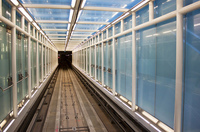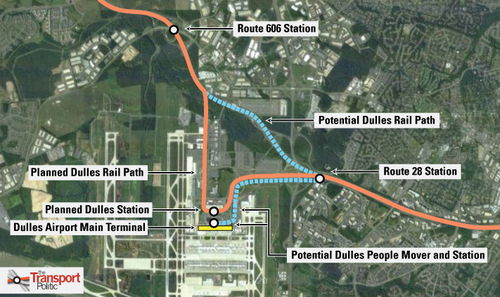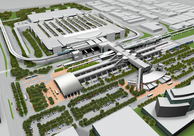People mover vs rail to Dulles saves more than money

Photo by thisisbossi on Flickr.
A proposal to use a people mover instead of Metro for the final 1.5 miles of transit to Dulles Airport drew criticism here and from airports authority board members. But this could actually save traveling time as well as money, and is an effective practice in many other cities.
On Tuesday, Robert Brown, a member of the Metropolitan Washington Airports Authority (MWAA), suggested rethinking his agency’s planned Metro rail extension out to Dulles Airport.
Instead of bringing this $2.8 billion rail link directly to the airport, Brown noted that replacing the final 1.5-mile connection with a people mover would save $70 million thanks to a more limited right-of-way and the construction of one fewer Metro station.
Perhaps unsurprisingly, the idea was perceived as heresy, both by Dan Malouff and MWAA board members. Mame Reiley, one board member, said, “I just don’t think that’s what we labored for… it is not rail to Dulles.”
Board members raised concerns that the federal government might delay the program because the board was “starting over.” And indeed the proposal appears to have been dismissed by the authority board as unacceptable.
But such a change could be a reasonable money-saver and may actually improve transit service for both commuters and air travelers. The question is immediately relevant to the Dulles Rail extension, but also equally valid to many cities, as the issue of extending rail networks out towards airports is frequently of concern for transportation planners in major metropolitan areas.
The question of how to reach Dulles by rail has been fraught with controversy since project development began. Originally, the concept was to connect the Metro line to an underground station about 550 feet from the main terminal, but after the project’s price tag had exploded past $3 billion, cost-savings became necessary.
The MWAA, which runs Dulles Airport in addition to the Metro extension, eventually agreed in July 2011 to move the stop about 600 feet farther away and to elevate it above the ground. Riders wanting to get off at Dulles will have to make the more than thousand-foot walk from the station to check-in.
Brown’s likely stillborn proposal to replace the direct rail link with a people mover reflects the fact that riders are likely to see this connection as inconvenient, especially compared with that at Reagan National Airport, where customers only have to walk about 150 feet between Metro platform and the terminal entrance.
Brown suggested rerouting the Metro line away from the airport (the existing plan is shown in orange below and would be about 4 miles from Route 28 to Route 606), so that it runs directly along the Dulles Greenway (in blue, about 2.5 miles from Route 28 to Route 606). A people mover (also in blue, about 1.5 miles) would connect the Route 28 station to the front of the terminal.
Though customers would have to transfer, they would now get a more direct journey, since it would be far easier to fit in front of the terminal the tracks and station for the people mover than it would have been for the Metro line (and in fact this explains why that latter possibility was never brought up).
This would save a total of $70 million, according to planner estimates, because it would replace about 1.5 miles of very expensive Metro infrastructure (readied for eight-car trains) with much lighter automatic people mover infrastructure, designed for one- or two-car trains.
We know this would save some money. How would this change affect customers?
Riders commuting in to Tyson’s Corner, Arlington, or Washington from outer suburban destinations on the end of the rail line west of Dulles would save time: At the 35-mph average speed expected for Silver Line trains,* it will take about 6.9 minutes to get from Route 28 to Route 606 using the current plan. The more direct route proposed by Brown would reduce that journey to 4.3 minutes. That’s almost half an hour in saved travel time per week per commuter.
Even better, those using the Silver Line to get to and from the airport might actually save time travelling too.** Though these customers would have to transfer between Dulles Metro and the people mover, if that connection were timed and across the platform (as is quite possible when two automated systems are linked and built at the same time), the time lost would be only two or three minutes.
Meanwhile, once they actually get off at the terminal, the experience of riders taking the people mover would be much superior: Rather than walking 1,150 feet to the terminal, which would take them about 4.8 minutes on average, they would walk something more like 150 feet, which would take them only 0.6 minutes.*** See this back of the envelope comparison:
| Arrive at Rt 28 station | Timed transfer to people mover | Time to Dulles Airport station | Walk to terminal | Total travel time | |
| Existing proposal | 0 min | — | 2.5 min | 4.8 min (or about 3 min with moving walkway) | 5.5-7.3 min |
| People mover proposal | 0 min | 3 min | 2.5 min | 0.6 min | 6.1 min |
Though the use of the people mover raises questions about operating another rail system, it could be maintained with similar vehicles as those already servicing Dulles on the Aerotrain, which connects checked-in passengers to the terminals.
The Washington region would not be alone if it chose to make its airport rail link stop somewhat short of the terminal itself. In Phoenix, the new light rail system was built in coordination with airport officials, who are currently constructing an automated train between the rail station and the terminals. The San Francisco Bay Area is building an airport connector to the Oakland Airport that will link a BART station some miles away to the terminals.
And Miami’s new AirportLink Metro Rail project will not actually stop at the airport, but instead at a new central station with transfers to a people mover.
Riders in these regions will not suffer; they may lose a few minutes transferring between trains, but if the connection is short and timed, that pain can be minimized. Avoiding the airport, paradoxically enough, could both save money and improve the situation for riders.
* 35 mph: PlanItMetro projects it will take about 22 minutes to travel the 12.8 miles between Dulles Airport and Tysons 7 Station.
** The only customers would would lose out with this change would be those traveling to and from Dulles from outer-suburban locations.
*** Assuming that people with bags travel at about 4 feet/second, a bit slower than the average walking speed of an elderly person.
Cross-posted at The Transport Politic.


